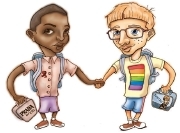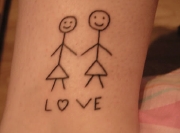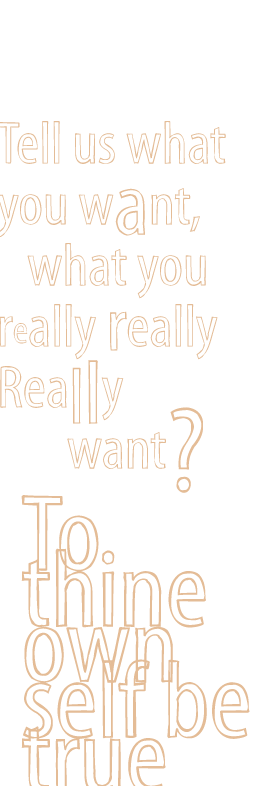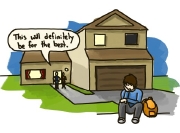








 |
|
||||||||
 |
 |
||||||||
|
|
|||||||||
 |  |
 |
|||||||
 |
 |
||||||||
 |
|||||||||
|
|
|
|
|
|
|
|
|
|
|

Welcome to the Club!
So, what comes first? You might be in school or you might be somewhere completely different. And there it is! This feeling inside you that makes you all warm and fuzzy and that is really nice. You fancy somebody. The only strange part is that the person is of the same sex as yourself.
What does that mean? What does that say about you? What will people think?
It's kinda hard to find a sweetheart if noone is supposed to know that you are LGB. Admitting to feeling you are another gender, even if only temporarily might not be enough if there's nobody to acknowledge who you really are.
The tricky part is finding the way to come out to others as you wish. So many places where you can identify yourself as LGBT. It is only natural though that you will want some people aware of who you are. The closer the people the more difficult the whole comming out may be.
Help us help you, share your thoughts, fill out our 'Youth' form here
Email us at gayyouthwexford@gmail.com or drop by our facebook page : Gay Youth Wexford

Stage 1 : Pre-Coming Out
Many people may be uncertain about their sexual identity, and need time to explore this. It is possible that at a conscious or pre-conscious level the child and family members know that the child's sexual orientation 'differs'. Often the person in question feels alienated and 'different', and fear of rejection and ridicule creates a barrier to the open acknowledgment of homosexual feelings. As a consequence, the person resolves the conflict through the use of certain defence mechanisms such as denial, repression, or sublimation (channelling of conflictual feelings into 'socially acceptable' behaviour).
The attempts to deny or repress feelings may lead to behavioural problems, psychosomatic illness (physical illness due to mental or emotional stress and strain), depression, low self-esteem, and even suicide. Others may sublimate their feelings and become intensely absorbed in some socially valued activity such as schoolwork, religion, music, or art, areas where being alone is not regarded as strange.
Facing the personal crisis of being 'different' is the healthy approach to adopt. This is the process of "coming out". It can begin at any age, depending on a number of factors, including family, individual personality, and friends.
Stage 2 : Coming Out
The first step in "coming out" is "outing" yourself to yourself, acknowledging what you feel and who you are. This first step in identifying yourself as gay or bisexual can take many years to complete.
One technique to help in this process is to look at yourself in the mirror, see yourself for who you are, accept yourself and say "I am gay" or "I am bisexual". Say it slowly over and over again. Another exercise is to find a quiet place to go for a walk. Bring a piece of paper and a pen. Write at the top of the sheet of paper "I am gay" or "I am bisexual". In another column write all the negative words and phrases used against homosexuals and bisexuals. Read and face the words used against gays and bisexuals. By doing this you can help yourself to become desensitised to these negative reactions to gay and bisexual people.
It is important that you carefully choose the people to whom you disclose your sexual orientation. Confiding in the most caring and accepting people is very important. Trustworthiness is also vital because those people will have to keep the news private. It is important that you keep control over the "coming out" process. Once you gain acceptance from a number of people it is much easier to withstand rejection by others, and there is always the possibility that people will react negatively. It is important to master ways to handle such situations and to cope with any related stress. It is a completely normal reaction for friends to be surprised and for them to need time to digest the news. And remember, if someone has a problem with your sexual orientation it is their problem, not yours.
We would suggest telling two close friends at the same time. After you have told them, they will need to talk about it to someone else. By telling two people, you give them the opportunity to support each other and you, at the same time.
There are many reasons why parents may not be the first family members you tell. Parents may not necessarily be directly involved in your life any longer, or you may be closer to your siblings and may wish to "come out" to them first. Many parents have expectations of their children, whether straight or gay, that children can rarely meet. It is possible that parents may accept that their child is gay/bisexual immediately, however this is frequently not the case. It has taken you some time to come to terms with your sexuality, so your parents and friends need a time for adjustment too, to deal with your "coming out". So, be patient with them.
Searching for gay/bisexual friends and companions no longer centres around going to gay bars. The gay community today has newspapers, bulletin-boards, and community centres. Gay bars are like "straight" bars, a place for people to meet and have a drink. The newest and fastest growing way that homosexual people are meeting is on-line (internet).
When you finally meet other gay people, "coming out" to them will not be a major task. However, developing a family of gay friends is not something that is accomplished over a short period. As in other areas of life, it takes time to develop solid friendships and bonds with people.
Stage 3 : Exploration/Experimentation
This is a period of exploring and experimenting with a new sexual identity, and there are several developmental tasks involved.
The first is the development of interpersonal skills in order to socialise with others with a similar sexual orientation. Having been socialised as heterosexuals, homosexual individuals may lack these skills.
Secondly, there is a need for some to develop a sense of personal attractiveness and sexual competence.
Finally, for some there is a need to recognise that self-esteem is not based on sexual conquest, but is rather a feeling of self worth of being happy with oneself.
Stage 4 : Initial Relationships
The main task of this stage is to learn how to function in a homosexual relationship. The yearning for a more stable, committed relationship can be sabotaged by internal lingering negative attitudes about homosexuality. The fact that homosexual people have very few role models in terms of intimate relationships, and the lack of public support for such relationships, makes this task even more difficult than is the case for heterosexuals.
Stage 5 : Integration
This is an ongoing process of development where new feelings about yourself continue to emerge - reintegration and self-definition takes place. Public and private identities are incorporated into a coherent self- image. Relationships at this point can be more successful than first relationships.
